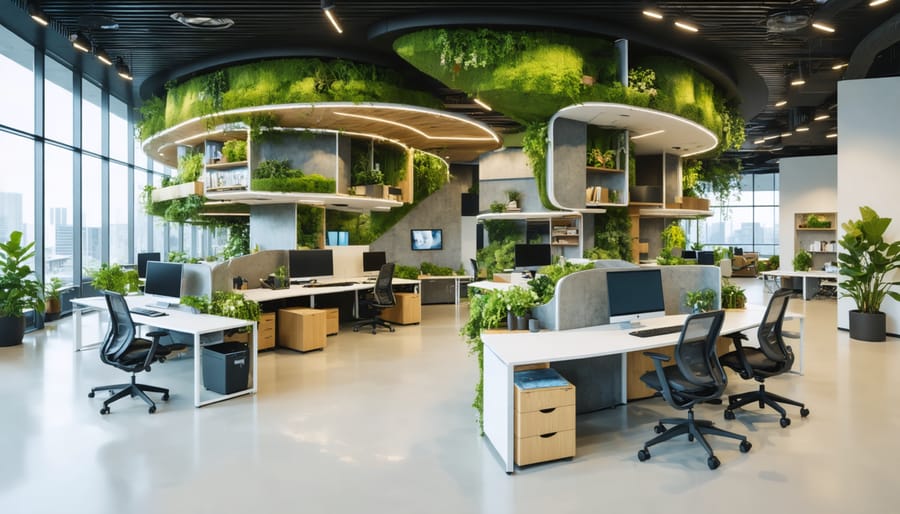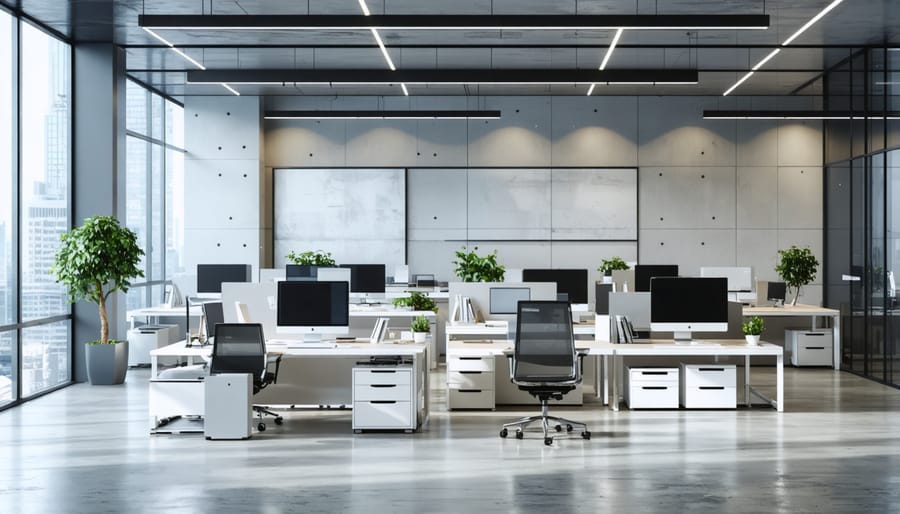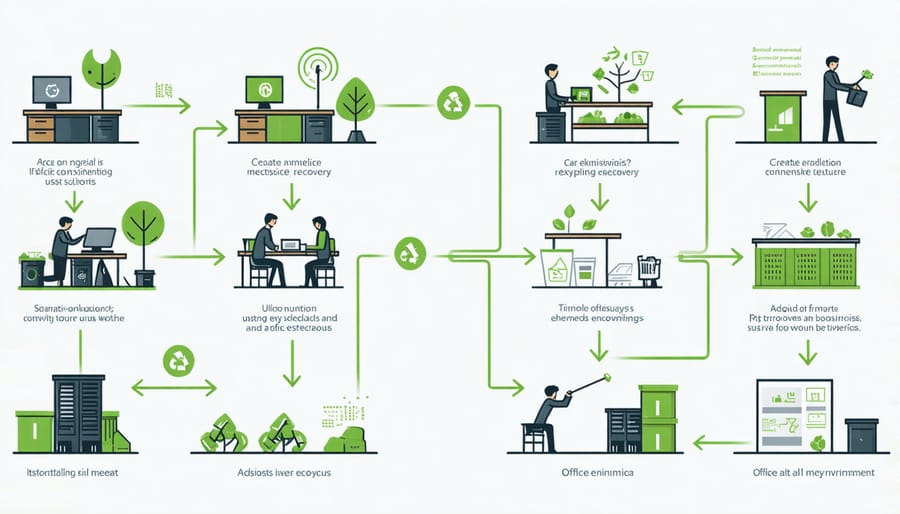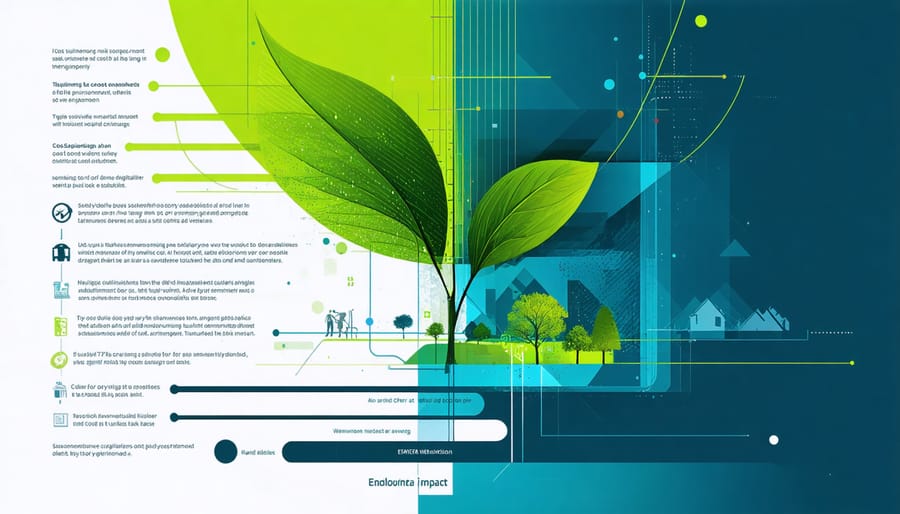
Transform Your Office: How This Tech Company Saved $50K with Circular Design
Transform office waste into valuable resources through a groundbreaking circular economy model that’s revolutionizing how businesses approach sustainability. Leading furniture manufacturer Herman Miller demonstrates this powerful concept by recycling old office chairs into new products, reducing landfill waste by 85% and saving $4 million annually. Through implementing sustainable workplace practices, companies can replicate this success by establishing take-back programs, redesigning products for disassembly, and creating closed-loop material flows. Modern workspaces now function as living laboratories for circular innovation, where everything from carpet tiles to lighting fixtures gets a second life through smart design and strategic material recovery. This practical approach to sustainability not only slashes operational costs but also creates new revenue streams while meeting growing consumer demand for environmentally responsible business practices.
The Challenge: Traditional Office Waste
When a growing tech company assessed their office space in downtown Seattle, they discovered an alarming reality about their workplace practices. Despite their digital-first approach to business, they were generating over 2,000 pounds of waste monthly, primarily from single-use office supplies, disposable kitchen items, and outdated furniture.
The company’s traditional office setup relied heavily on disposable materials: paper cups for coffee breaks, plastic water bottles, single-use printer cartridges, and conventional office furniture that needed replacement every few years. Their break room alone was producing hundreds of pounds of waste from disposable utensils and packaging. The office’s lighting system was energy-inefficient, running 24/7 regardless of occupancy, while the HVAC system operated on an outdated timer that didn’t account for actual usage patterns.
What’s more, their office renovation cycles followed a typical “take-make-dispose” model. Every three to five years, perfectly functional furniture would be discarded to make way for new pieces, contributing to landfill waste and unnecessary resource consumption. The company’s leadership realized their workplace practices weren’t just environmentally unsustainable – they were also costly, with waste management and frequent replacement cycles eating into their operational budget.
This wasteful approach didn’t align with their innovative company culture or their employees’ growing environmental consciousness. It was clear that a fundamental change was needed.
Implementing Circular Design Solutions

Modular Furniture Systems
Modular furniture systems represent one of the most innovative sustainable furniture solutions in the circular economy. These adaptable pieces can be easily reconfigured, repaired, and updated, extending their lifecycle and reducing waste. Instead of disposing of entire furniture sets when needs change, modular systems allow users to add, remove, or modify components as required.
For example, a modular office desk system might start as a simple workstation but can evolve into a collaborative workspace by adding connecting pieces. When teams grow or shrink, these systems adapt without requiring complete replacement. The components are designed for easy disassembly, making repairs straightforward and enabling the replacement of worn parts rather than entire units.
Many modern modular systems also incorporate eco-friendly materials like recycled plastics, sustainable wood, and biodegradable fabrics. This approach not only supports environmental conservation but also creates flexible, future-proof spaces that can evolve with changing needs while maintaining style and functionality.
Material Recovery Program
A key component of our circular economy initiative is the comprehensive material recovery program, which transforms how we handle furniture and materials at their end-of-life stage. Instead of sending old furniture to landfills, we’ve implemented a systematic approach to breaking down and recycling various components. Wood pieces are repurposed into new furniture or decorative elements, while metal components are separated and sent to specialized recycling facilities.
We’ve partnered with local craftsmen who refurbish salvageable pieces, giving them new life through creative upcycling. For materials that can’t be directly reused, we’ve established relationships with recycling centers that specialize in different materials – from fabrics to plastics to metals. This program has resulted in a 75% reduction in waste disposal costs and has created a sustainable loop where materials continuously flow back into the production cycle.
The system also includes a digital tracking platform that monitors the journey of each piece, ensuring transparency and accountability throughout the recovery process.

Lease-Based Equipment Model
A growing number of businesses are embracing the lease-based equipment model as a sustainable alternative to traditional purchasing. Instead of buying printers, computers, and office furniture outright, companies now lease these items from manufacturers who maintain ownership and responsibility for maintenance. When equipment needs upgrading, it’s returned to the manufacturer for refurbishment or recycling, while the business receives updated models. This approach significantly reduces electronic waste and extends product lifespans. Companies like Philips Lighting have pioneered “light as a service,” where clients pay for illumination rather than owning fixtures. Similarly, furniture manufacturers now offer subscription-based office furnishing solutions, ensuring items stay in circulation rather than ending up in landfills. This model not only reduces environmental impact but also provides businesses with flexible, scalable solutions and predictable monthly costs.

Measurable Impact and Results
Cost Savings
Implementing circular economy principles in workspace design can lead to substantial financial benefits. Our case study revealed that companies adopting cost-effective workspace design strategies saw an average reduction of 30% in operational costs within the first year.
The breakdown of savings typically includes:
– 40% reduction in furniture procurement costs through refurbishment and modular designs
– 25% decrease in energy consumption using smart lighting and HVAC systems
– 35% savings on waste management through improved recycling programs
– 20% reduction in maintenance costs due to durable, sustainable materials
Additionally, businesses reported increased employee productivity worth an estimated $2,000 per worker annually, attributed to improved workspace functionality and comfort. Tax incentives and green building certifications provided further financial advantages, with some companies receiving up to $50,000 in annual tax credits for sustainable practices. The initial investment in circular design elements typically achieved ROI within 18-24 months, making it an attractive option for budget-conscious organizations.
Environmental Benefits
The circular economy model delivers substantial environmental benefits by significantly reducing waste and carbon emissions throughout the workspace lifecycle. By implementing reuse and recycling practices, businesses can decrease their landfill contribution by up to 70%. The refurbishment of existing furniture alone prevents thousands of pounds of waste from entering landfills annually while saving trees and reducing manufacturing emissions.
Energy consumption also sees a marked improvement, with circular practices typically resulting in 25-40% lower carbon emissions compared to traditional linear models. This reduction comes from decreased manufacturing needs, optimized transportation routes, and the use of energy-efficient refurbishment processes.
Water conservation is another key benefit, as furniture refurbishment uses approximately 80% less water than new production. Additionally, by choosing sustainable materials and implementing repair programs, businesses extend product lifecycles by 2-3 times, further reducing their environmental impact.
These measurable benefits make the circular economy not just an environmentally conscious choice, but a practical solution for businesses looking to reduce their ecological footprint while maintaining high-quality workspace environments.
Practical Tips for Implementation
Ready to transform your workspace into a circular economy model? Here are practical steps you can implement today:
Start with a waste audit to identify your biggest opportunities. Track everything that goes into trash bins for a week, noting patterns and potential recyclables. This baseline will help measure your progress.
Create designated recycling stations throughout your workspace, clearly labeled with visual guides. Position these near high-traffic areas and ensure they’re easily accessible. Consider adding composting bins for organic waste if appropriate.
Implement a “materials library” where reusable items can be stored and shared. This could include office supplies, packaging materials, or furniture components. Organize items by category and maintain an inventory system.
Partner with local recycling facilities and waste management companies. Many offer free consultations and can help optimize your collection systems. They might also connect you with other businesses for material exchange programs.
Choose modular furniture and equipment that can be easily repaired, upgraded, or reconfigured. When purchasing new items, prioritize those made from recycled materials or designed for eventual recycling.
Digitize wherever possible to reduce paper waste. Set up cloud-based document sharing, implement double-sided printing by default, and use digital signatures for contracts.
Engage your team through training sessions and regular updates. Create a green team to champion initiatives and recognize departments that show improvement. Consider implementing incentive programs for waste reduction.
Start small and scale up gradually. Focus on one area or department initially, learn from the experience, and then expand successful practices across your workspace. Remember that creating a circular economy is an ongoing journey rather than a destination.
Monitor and measure your progress regularly. Keep track of waste reduction, cost savings, and positive environmental impact to maintain momentum and justify further investments in circular initiatives.
The circular economy offers a powerful framework for creating sustainable, efficient workspaces that benefit both the environment and your bottom line. By implementing the strategies we’ve discussed – from furniture reuse and modular design to smart waste management systems – you can significantly reduce your environmental impact while creating a more productive workspace. Remember, transitioning to a circular model doesn’t have to happen all at once. Start with small, manageable changes like implementing a recycling program or choosing refurbished furniture for your next office update. Each step forward contributes to the larger goal of sustainability.
As you’ve seen from our examples, the benefits extend beyond environmental impact. Reduced operational costs, improved employee satisfaction, and enhanced brand reputation are just a few of the advantages you can expect. Whether you’re a small business owner or facility manager, the circular economy principles can be adapted to suit your specific needs and scale.
Take action today by assessing your current workspace and identifying areas where you can implement these circular solutions. The future of sustainable workspaces is circular, and the time to start is now.
